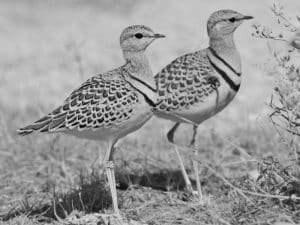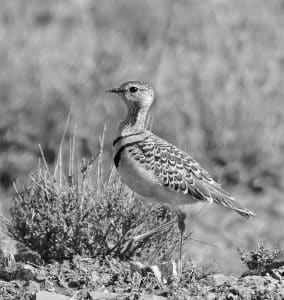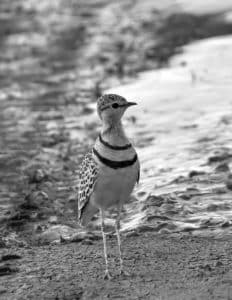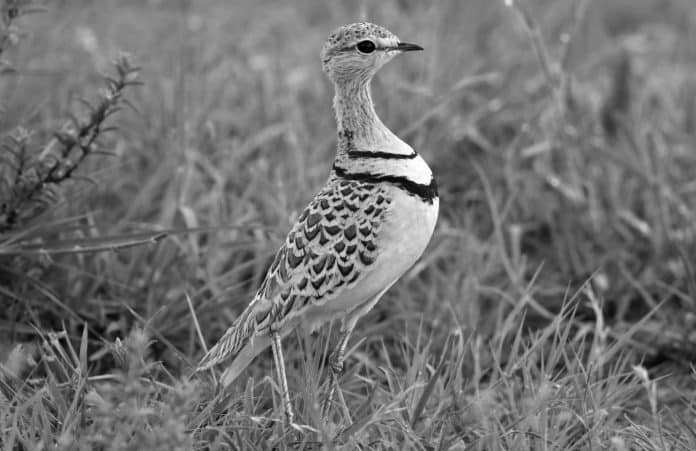Introduction to the double-banded courser
The double-banded courser in Tanzania (Rhinoptilus africanus), also known as the two-banded courser, is a fascinating bird species that can be found in the beautiful country of Tanzania. With its unique appearance and behavior, the double-banded courser is a true gem for birdwatching enthusiasts and nature lovers alike.
Habitat and distribution of the double-banded courser in Tanzania

The double-banded courser is primarily found in the arid and sandy regions of Tanzania, particularly in the central and northern parts of the country. These areas include the Serengeti National Park, Tarangire National Park, and the Ngorongoro Conservation Area.
This bird species prefers open grasslands, savannas, and semi-desert habitats, where it can blend seamlessly with its surroundings. The sandy terrain provides the perfect camouflage for the double-banded courser, allowing it to hide from potential predators and prey.
Physical characteristics and behavior of the double-banded courser
The double-banded courser is a medium-sized bird, measuring about 25 to 30 centimeters in length. It has a distinct appearance, with a sandy-brown plumage that allows it to blend in with the desert landscape. The bird also features two prominent black bands across its breast, giving it its name.
One of the most fascinating aspects of the double-banded courser is its unique behavior. It is primarily active during the night, making it a nocturnal species. This behavior helps the bird avoid the scorching heat of the day and also allows it to hunt for insects and small invertebrates under the cover of darkness.
Conservation status and threats to the double-banded courser
The double-banded courser is classified as a species of least concern by the International Union for Conservation of Nature (IUCN). However, it faces certain threats that could potentially impact its population in the future.
One of the main threats to the double-banded courser is habitat loss due to human activities such as agriculture and infrastructure development. The conversion of natural habitats into farmland and settlements disrupts the bird’s nesting sites and foraging areas, leading to a decline in its population.
Tips for spotting the double-banded courser in Tanzania

Spotting the elusive double-banded courser in Tanzania can be quite a challenge due to its secretive nature and excellent camouflage. However, with a little patience and some expert guidance, you can increase your chances of a successful sighting.
First and foremost, it is recommended to visit the bird’s preferred habitats during the early morning or late evening hours when it is most active. Look for open grasslands and sandy areas where the bird can easily blend in. Pay close attention to any movement or slight disturbances in the sand, as the double-banded courser might be foraging for food.
Best time and locations for birdwatching the double-banded courser in Tanzania
The best time to spot the double-banded courser in Tanzania is during the dry season, which typically runs from June to October. During this period, the bird is more likely to venture out into open areas in search of food and water.
Some of the prime locations for birdwatching the double-banded courser in Tanzania include the Serengeti National Park, Tarangire National Park, and the Ngorongoro Conservation Area. These areas offer a combination of suitable habitat and a higher chance of sightings.
Interesting facts about the double-banded courser
- The double-banded courser is a highly specialized bird that has evolved to survive in the harsh desert environment of Tanzania.
- This species has the ability to remain motionless for long periods, relying on its excellent camouflage to avoid detection.
- The double-banded courser is known for its unique vocalizations, which consist of a series of soft, rolling calls.
- Unlike most birds, the double-banded courser does not build nests. Instead, it lays its eggs directly on the sandy ground, relying on the camouflage of the eggs to protect them from predators.
Other bird species found in the same habitat as the double-banded courser
The habitat of the double-banded courser is home to a diverse range of bird species, each with its own unique characteristics and behaviors. Some of the other bird species you may encounter while birdwatching in Tanzania include:
- Lilac-breasted roller (Coracias caudatus)
- Secretary bird (Sagittarius serpentarius)
- Fischer’s lovebird (Agapornis fischeri)
- Grey-crowned crane (Balearica regulorum)
- Kori bustard (Ardeotis kori)
Recommended birdwatching tours and guides for seeing the double-banded courser in Tanzania

If you’re planning a birdwatching trip to Tanzania and hoping to see the double-banded courser, it is highly recommended to join a guided tour led by experienced birdwatching guides. These guides have extensive knowledge of the local bird species and can help you navigate the best locations and increase your chances of spotting the double-banded courser.
Some reputable birdwatching tour companies and guides in Tanzania include:
- Tanzania Birding Tours
- African Birding Safaris
- Birding with the Experts
Conclusion: The beauty and rarity of the double-banded courser in Tanzania
The double-banded courser is a rare and captivating bird species that can be found hidden in the sandy landscapes of Tanzania. With its unique appearance, behavior, and habitat preferences, it offers a truly remarkable birdwatching experience for those lucky enough to spot it.
As with any wildlife species, it is important to prioritize the conservation of the double-banded courser and its habitat. By raising awareness and supporting sustainable practices, we can ensure that future generations have the opportunity to appreciate and admire this extraordinary bird in the wild.


































